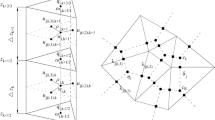Abstract
A semi-analytical method is presented for constructing a global orthogonal curvilinear ocean mesh which has no singularity point inside the computational domain since the mesh poles are moved to land points. The method involves defining an analytical set of mesh parallels in the stereographic polar plan, computing the associated set of mesh meridians, and projecting the resulting mesh onto the sphere. The set of mesh parallels proposed here is defined as a series of embedded circles. The resulting mesh presents no loss of continuity in either the mesh lines or the scale factors over the whole ocean domain, as the mesh is not a composite mesh. Thus, the Bering Strait can be opened without specific treatment. The equator is a mesh line, which provides a better numerical solution for equatorial dynamics. The resolution can be easily controlled through the definition of three analytical functions which can increase resolution and/or maintain a low ratio of anisotropy. The mesh has been implemented in the LODYC general circulation ocean model. Results of a semi-diagnostic simulation are shown.
Similar content being viewed by others
References
Aagaard K, Carmark EC (1989) The role of sea ice and other fresh water in the Arctic circulation. J Geophys Res 94:14485–14498
Blanke B, Delecluse P (1992) Variability of the tropical Atlantic ocean simulated by a general circulation model with two different mixed layer physics. J Phys Oceanogr 23:1363–1388
Bryan F (1987) Parameter sensitivity of primitive equation ocean general circulation models. J Phys Oceanogr 17:970–985
Bryan K, Manabe S, Pacanowski RC (1975) A global ocean atmosphere climate model. Part 11. The oceanic circulation. J Phys Oceanogr 5:30–46
Coachman LK, Aagaard K (1988) Transports through Bering Strait: annual and interannual variability. J Geophys Res 93:15535–15539
Coward AC, Killworth PD, Blundell JR (1994) Tests of a two-grid world ocean model. J Geophys Res 99:22725–22735
Delecluse P, Madec G, Imbard M, Lévy C (1993) OPA version 7 Ocean General Circulation Model reference manual. LODYC, France, Internal Report, 93/05, 111 pp (Available from Laboratoire d'Océanographie Dynamique et de Climatologie, Université Paris VI, 75252 Paris, France)
Deleersnijder E, Van Ypersele JP, Campin JM (1993) An orthogonal, curvilinear coordinate system for a world ocean model. Ocean Modelling 100 (unpublished manuscript)
Eby M, Holloway G (1994) Grid transformation for incorporating the Arctic in a global ocean model. Clim Dyn 10:241–247
Esbensen SK, Kushnir Y (1981) The heat budget of the global ocean: an atlas based on estimates from marine surface observations. Climatic Resolution Institution, Oregon State, University, Rep 29
ETOPO5 (1986) Global 5′ × 5′ depth and elevation. (Available from National Geographical Data Center, NOAA, US Department of Commerce, Code E/GC3, Boulder, CO 80303)
Guilyardi E, Madec G, Terray L, Déqué M, Pontaud M, Imbard M, Stephenson D, Filiberti MA, Cariolle D, Delecluse P, Thual O (1995) Simulation couplée ocean-atmosphere de la variability du climat. C R Acad Sci Paris, 320, Série Ila, 683–690
Gwilliam CS (1995) The OCCAM Global Ocean Model. In: Hoffman G-R, Krietz N (eds) Coming of Age (Proc 6th ECMWF Workshop on the use of parallel processors in meteorology), World Scientific
Hellerman S, Rosenstein M (1983) Normal monthly wind stress over the World Ocean with error estimates. J Phys Oceanogr 13:1093–1104
Herman GF; Johnson WT (1980) The effect of extreme sea ice variations on the Climatology of the Goddard general circulation model. In: Pritchard ED (ed) Sea ice processes and models. University of Washington, Seattle, pp 207–223
Levitus S (1982) Climatological atlas of the Word Ocean. NOAA Prof Pap 13, CS Government Printing Office, Washington D.C.
Marti O, Madec G, Delecluse P (1992) Comment on “net diffusivity in ocean general circulation models with nonuniform grids” by F. L. Yin and I. Y. Fung. J Geophys Res 97:12763–12766
Murray RJ (1995) Explicit generation of orthogonal grids for ocean models. J Comput Phys (accepted)
Mysak LA, Manak DK, Marsden RF (1990) Sea-ice anomalies observed in the Greenland and Labrador Seas during 1901–1984 and their relation to an interdecadal Arctic climate cycle. Clim Dyn 5:111–133
Reason CJC, Power SB (1994) The influence of the Bering Strait on the circulation in a coarse resolution global ocean model. Clim Dyn 9:363–369
Rudels B (1989) The formation of polar surface water, the ice export and the exchanges through Fram Strait. Prog Oceanogr 22:205–248
Semtner AJ, Chervin RM (1988) A simulation of the global ocean circulation with resolved eddies. J Geophys Res 93:15502–15522
Semtner AJ, Chervin RM (1992) Ocean general circulation from a global eddy-resolving model. J Geophys Res 97:5493–5550
Washington WM, Meehl GA (1986) General circulation model CO2 sensitivity experiments: snow-sea ice albedo parameterization and globally averaged surface air temperature. Clim Change 8:231–241
Author information
Authors and Affiliations
Rights and permissions
About this article
Cite this article
Madec, G., Imbard, M. A global ocean mesh to overcome the North Pole singularity. Climate Dynamics 12, 381–388 (1996). https://doi.org/10.1007/BF00211684
Received:
Accepted:
Issue Date:
DOI: https://doi.org/10.1007/BF00211684



